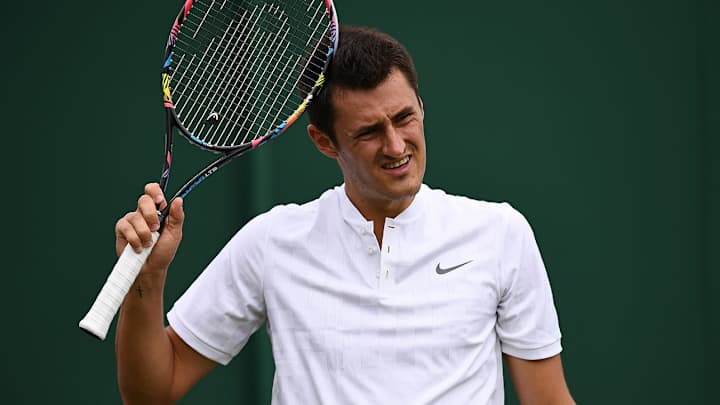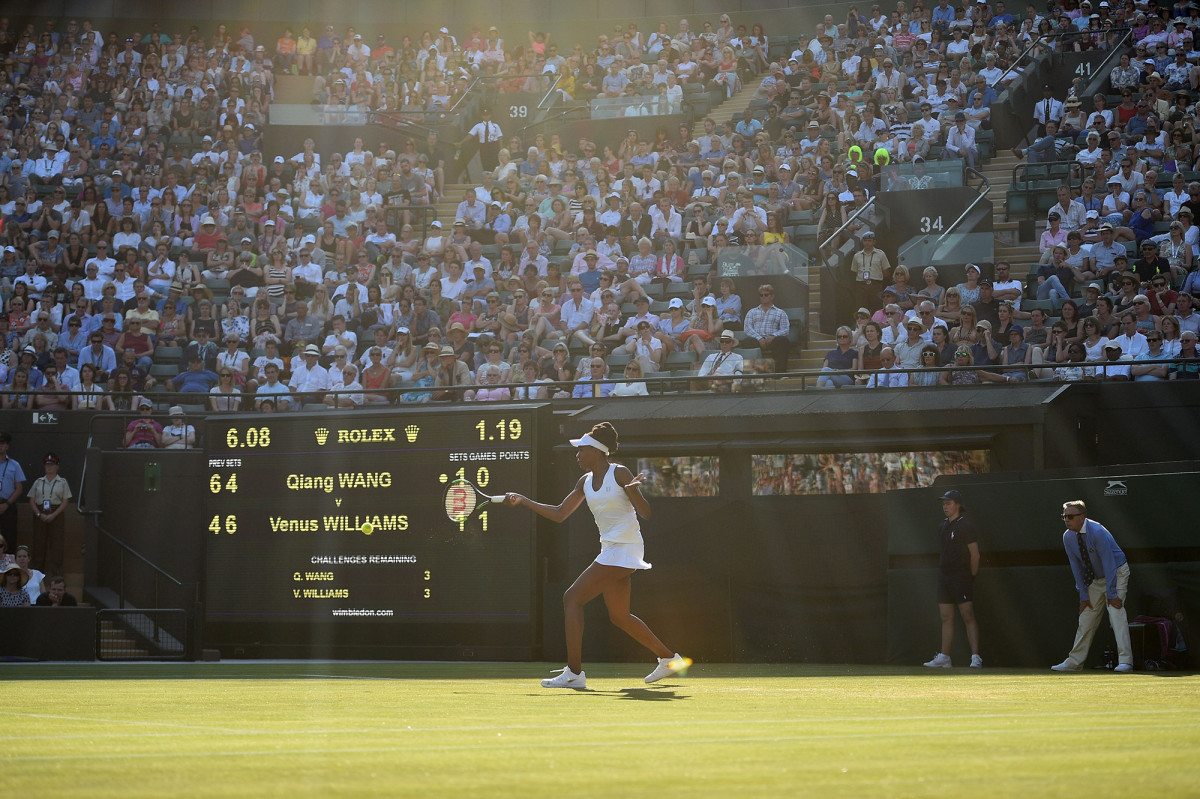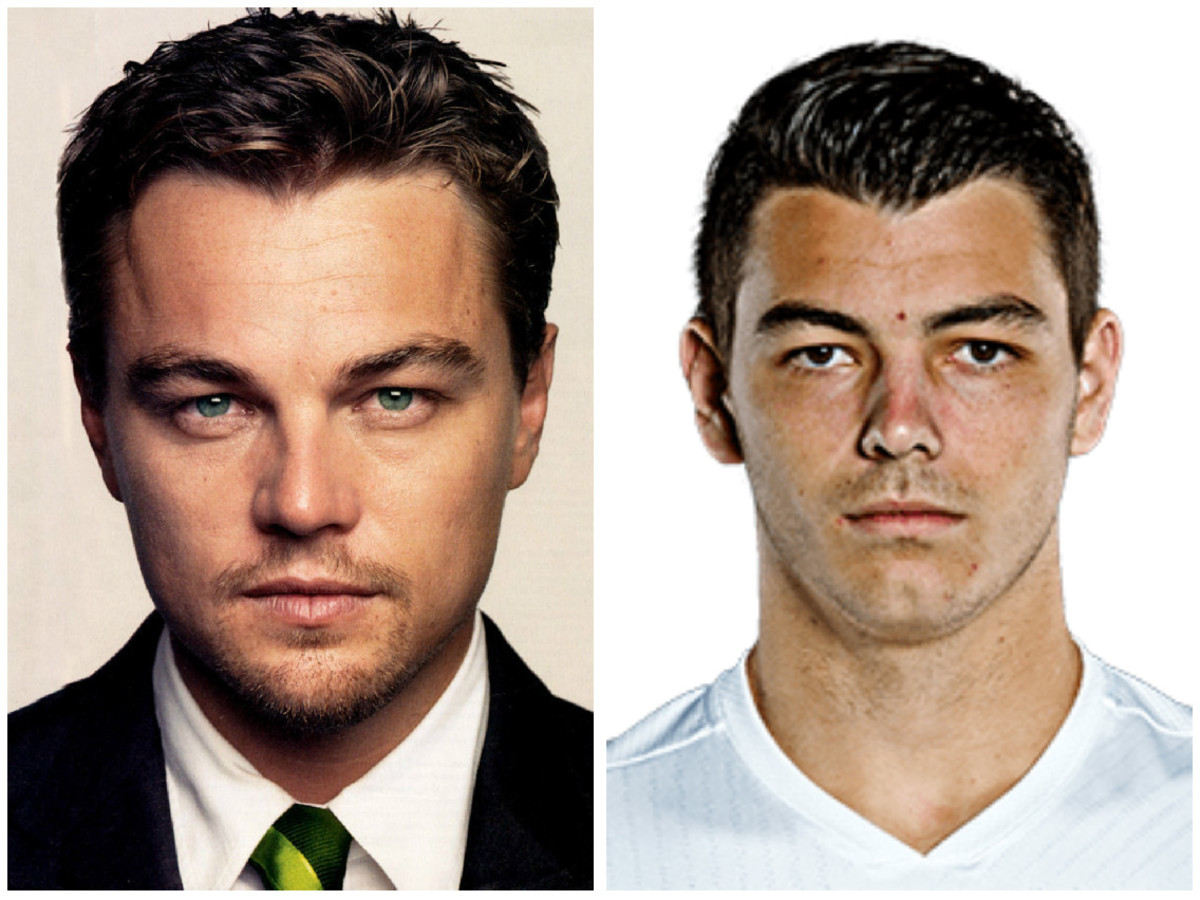Mailbag: Bernard Tomic's comments, Hawk-Eye and more from Wimbledon

LONDON – Questions are piling up so let’s do a Mailbag on an otherwise slow Day Three….
Have a question or comment for Jon? Email him at jon_wertheim@yahoo.com or tweet him @jon_wertheim.
I get it, everyone is pissed, Bernard Tomic and his follies rule the day. Do we need another ex-pro/tennis analyst/blogger hammering on this guy? Our sacred ground is not his sacred ground. Is he depressed? Is his Dad behind it? Who knows. Clearly, he is unhappy. We know Tomic as a prodigy with an angry dad, aka Mary Pierce—she didn't last long, he won't either. His assumption that he will play another ten years is misguided and ignorant and absurd—he is No. 59 and falling fast. I love his effortless game—maybe a flag waving ex-pro (outside Australia) can drop the bloated patriotism and reach out.
—Jeffery Nielsen, Thornton, Colo.
• Totally with you. I think I wrote at the French Open that Tomic has become tennis’ Nickelback/Smashmouth. That is, the act we’re all almost expected to mock and dislike. And the persistently halfhearted performances are disgraceful, especially when you see so many players (cue Marcus Willis) who would chop off pinkies to play Wimbledon just once. But yesterday’s Pressroom Confession was a cry for help, the devil-may-care monologue of a confused 25-year-old who sounds like he might have a touch of mental illness and—too often we forget—is the son of a notorious tennis father.
As reader Lilas Pratt put it nicely: “You can't fix what you can't identify and being honest about what is going on at least seems like a good start in the right direction.”

Jon, Ostapenko won the French Open. Is there a chance we could see another unseeded player win Wimbledon? If so, who would it be?
—Charles, London
• Sure. In all likelihood, the winner will be seeded. (Through three days, the women’s draw has actually been quite formful so far.) But to use the 2017 cut-and-paste: “Especially with Serena out of the draw, the field has never been more wide open.” Some unseeded players to watch? Victoria Azarenka—who won on Wednesday and has looked dazzling in her last five sets—would be my first choice. It’s a dip after that (especially since Lucie Safarova snuck in at No. 32.)
With regard to one of the more unfortunate Wimbledon traditions, I want to make sure I have this right. The ATP rankings go: Murray, Nadal, Wawrinka, Djokovic, Federer. But Wimbledon amended it to: Murray, Djokovic, Federer, Nadal, and now, Wawrinka—who has spent all the effort grinding his way into the top four, then caught a break with a Djokovic slump, and got a boost to No. 3—is getting denied the benefit of having his own quarter of the draw at the one major where he hasn't broken through, specifically because he hasn't broken through there? Oof.
—Marco, Portland, Ore.
• I’m totally in favor of Wimbledon’s seeding formula. Inasmuch as seedings are supposed to, yes, reward players for what they’ve achieved but also be predictive, this is a perfect mix. The top four seeds have all won Wimbledon multiple times. Wawrinka has never been beyond the quarterfinals and has always been challenged by grass. Hindsight has corrective vision, of course. But when he lost in round one, the seeding formula was further validates.
July Fourth and Wimbledon share memorable moments in history
Hi Jon. Conventional wisdom has it that power players are not usually favored to win the French Open because their power is neutralized on the clay courts of Roland Garros. I am not so sure that is still the case. The past six champions at the French Open have all been power players Sharapova (twice), Serena (twice), Muguruza, and Ostapenko. Your thoughts?
—Dayo H., Memphis, Tenn.
• We can also note that players whose games are not based on power—Radwanska, Wozniacki, Strycova—can do perfectly well for themselves on grass. Some of this is the homogenization of surface. Some of this is the fact that grass rewards power but also rewards movement.
Yesterday Paul Annacone had an interesting point about aging David Ferrer, noting that grass was becoming his best surface. Why? Because it’s good for his movement-based game but it has also become the lone surface on which he can finish a point.
Petra Kvitova loses to American Madison Brengle in second round at Wimbledon
Sir Jon Wertheimalot,
What ever happened to one of your favorite adages: "You can't be a Slam favorite until you've been a Slam winner"? You always used to asterisk that at the end of any discussion of a player who was hot coming in to a Slam but had never "lifted" (as they say). And here you go boldly predicting Karolina Pliskova as the Wimbledon favorite. Don't get me wrong, she can totally do it, just thought you'd give it stronger justification.
PS: In a way, the adage sometimes plays to the advantage of players, by fully putting some of them out of the conversation. And with less attention & pressure, they might streak to the title (see: Ostapenko, Jelena).Cheers!!
—Ivan Himanen, RA
• What about this? “You can't be a Slam favorite until you have a winning record at the Slam in question.” Karolina Pliskova—your Wimbledon favorite—entered this year 4-5 for her career at the All England Club, never having survived the second round. Yet go down the list and you say: Serena is missing, Sharapova is missing, Azarenka is fresh back from maternity leave, Kerber is struggling, Halep might have scar tissue from failing to close out Paris last month….suddenly Pliskova seems like a reasonable, logical choice.
Of course you don't think Garrison Keillor is funny. You also don't think players shrieking like car alarms is worth worrying about. And you probably send steaks back if there's no ketchup on them. (Kidding. Mostly.)
—Doyle Srader, Eugene, Ore.
• John Oliver? That’s a humorist.
Swarms of flying ants have invaded Wimbledon
Shots, Miscellany
• Love this Simon Cambers piece on Andy Murray and Trainspotting.
• On the 50th anniversary of Open tennis, not the role of TV-BBC.
• Helen of Philly has LLS: Leonardo DiCaprio and Taylor Fritz.

• Reader Tom Witkin has this week’s reader rant about Hawk-Eye:
If you're a long-time tennis fan like me, John McEnroe's yells of "you cannot be serious" may still echo when you watch one of the major tournaments (Wimbledon just started, and the U.S. Open is played later this summer). If "Mac" still played today in the main draw, resolving player in-or-out "challenges" electronically through a terrific product called Hawk-Eye would no doubt have quieted the irascible one. But not silenced him. And it shouldn't.
This technology, used to confirm line calls at three of the four major tournaments (the French Open, the only one of the majors played on clay, still relies on ball marks left on the court), is a big improvement, but it's not perfect. Hawk-Eye’s website states that results show “the system to have a mean error of only 2.6mm when compared to a high speed camera located on the playing surface.” So, for the players and fans, when Hawk-Eye calls a ball in or out within that 2.6 mm threshold, there's a significant chance that it got the call wrong. (The chance is "significant," according to Marcel Blais, Associate Teaching Professor of Mathematical Sciences at Worcester Polytechnic Institute, who I consulted about the statistics, because "technically there’s always a small chance that the system gets any call wrong, but below 2.6mm that chance is large enough to be meaningful.")
Tomic can't 'find any motivation' at Wimbledon
So, here's a suggestion: When a player "Challenges" a call, and Hawk-Eye determines that the ball is out or in by less than the system's resolution—for example, out by one millimeter, when Hawk-Eye may be off by close to three millimeters—why not report the challenge as "too close to call," and revert to the line judge's original call? The NFL's and Major League Baseball's replay policies provide a precedent: when there isn't incontrovertible evidence to overturn, the call on the field (or diamond) stands. The difference in these tennis tournaments is that the lack of incontrovertible evidence is based statistically on technology.
And let's face it, the major tournaments aren't quite the same without the occasional "you cannot be serious."
